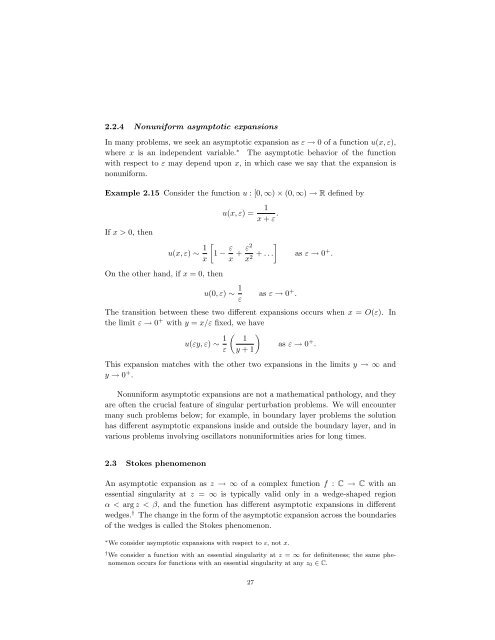Asymptotic Analysis and Singular Perturbation Theory
Asymptotic Analysis and Singular Perturbation Theory
Asymptotic Analysis and Singular Perturbation Theory
You also want an ePaper? Increase the reach of your titles
YUMPU automatically turns print PDFs into web optimized ePapers that Google loves.
2.2.4 Nonuniform asymptotic expansions<br />
In many problems, we seek an asymptotic expansion as ε → 0 of a function u(x, ε),<br />
where x is an independent variable. ∗ The asymptotic behavior of the function<br />
with respect to ε may depend upon x, in which case we say that the expansion is<br />
nonuniform.<br />
Example 2.15 Consider the function u : [0, ∞) × (0, ∞) → R defined by<br />
If x > 0, then<br />
u(x, ε) ∼ 1<br />
<br />
1 −<br />
x<br />
ε<br />
x<br />
On the other h<strong>and</strong>, if x = 0, then<br />
u(x, ε) = 1<br />
x + ε .<br />
u(0, ε) ∼ 1<br />
ε<br />
<br />
ε2<br />
+ + . . .<br />
x2 as ε → 0 + .<br />
as ε → 0 + .<br />
The transition between these two different expansions occurs when x = O(ε). In<br />
the limit ε → 0 + with y = x/ε fixed, we have<br />
u(εy, ε) ∼ 1<br />
<br />
1<br />
as ε → 0<br />
ε y + 1<br />
+ .<br />
This expansion matches with the other two expansions in the limits y → ∞ <strong>and</strong><br />
y → 0 + .<br />
Nonuniform asymptotic expansions are not a mathematical pathology, <strong>and</strong> they<br />
are often the crucial feature of singular perturbation problems. We will encounter<br />
many such problems below; for example, in boundary layer problems the solution<br />
has different asymptotic expansions inside <strong>and</strong> outside the boundary layer, <strong>and</strong> in<br />
various problems involving oscillators nonuniformities aries for long times.<br />
2.3 Stokes phenomenon<br />
An asymptotic expansion as z → ∞ of a complex function f : C → C with an<br />
essential singularity at z = ∞ is typically valid only in a wedge-shaped region<br />
α < arg z < β, <strong>and</strong> the function has different asymptotic expansions in different<br />
wedges. † The change in the form of the asymptotic expansion across the boundaries<br />
of the wedges is called the Stokes phenomenon.<br />
∗ We consider asymptotic expansions with respect to ε, not x.<br />
† We consider a function with an essential singularity at z = ∞ for definiteness; the same phenomenon<br />
occurs for functions with an essential singularity at any z0 ∈ C.<br />
27
















